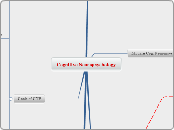Cognitive Neuropsychology
Success of CNP
But problems with central systems (problem solving)
Treatment / rehab of amnesics (JS)
Models of face recognition vs. emotinal express
Colthearts Model of dyslexia by testing lesioned brains (surface dyslexia= damage to lexical route)
vs Developemental dysl: difficulties learning
Cognitive Modelling: If lesioned do react the same?
Goals of CNP
Create / Support models
How to build models
Infer normal funcions from damaged systems
Double Dissotiation (different subsystems?)
Problems with Double Dissot.
damaged connnectionist models (single system) behaves like doulbe dissoti.
Could the patient use a compensatory strategy?(not really function on one task)
Normal functioning
not both below normal: otherwise perhaps one impaird function
What is normal performance?
How much degradation is impairment
differnt stimuli (tests) might lead to errors
Living / non living in two labs
It is therefore important to ensure that a patient is tested in a variety of ways to ensure that seemingly normal performance is being produced in a normal fashion
Why
Single disotiations: A but not B: --> A harder B?
Amisics loose A declarative but have B procedural
Where
Blindsight
Double Dis. in one Pateint: Differnt deficits blindsight vs. of intact vision
Memory
Amnesia
HM has deficient LTM but intact STM
KF has defective STM but intact LTM
Speech
Broca / Wernecke
Recognition
Face Reogniton vs. Emotional Expression Recogntion
Face Regocnition
Prosopagnosia
Not recognizing familiar persons
Capgras Delusion
Looks like wife but is imposter
Agnosia: (Object recog)
Goodale
Patient DFDorsal/ Ventral
Implicit OK: grasping diretion or hand size
Explicit No! Could not recognize even simple shapes
Humphreys & Riddoch: Recog. happening in stages
JF: semantics clear but cannot name
maybe more diffiuclt not different subsystems
single dissotiations
HJA: object: percept - doesn't look familiar
Split Brain
Ramachandran: Higher order lang. mean. trasf. cortically
Left analytical, right emotional
Sperry & Gazzaniga: Patients Left brain saw nothing: language / Right Spatial can draw object
Is model consistent with behaviour?
Data from other patients
Former:Localization of Function: Now Understanding Processes
Providing Treatments /How
Helping amnesics
HMs mirror drwaing improved (implicit learing)
Neuropage: implicitly learn to check the messenger to be reminded of...
Train procedural memory (JC ran own business)
Understanding lesions deficits
Assessment of deficit/What
Comp. data from other patients
Normal -Cog. Metods
Coltheart: Model IAC Modil based on errors shown by dyslexics
Memory tasks: Amnesics show recency effect/ not primacy
Standardised Tests
Birmingham Object Recognition
Wechsler Intelligence
Wechsler Memory
Brain Imaging:
Images: Determine the level of when sth. is coloured
Problem: Images will not show the "how"
Damasio: difficulity in recognition: tools (a glove: "appears to have 5 outpoutchings ...") / animals/ people: reduction in brain areas
Subtopic
Inteviews
Localization/where
Methods
Post Mortem brain examination (TAN)
Wisconsin Card Sorting Task: -sort cards to constanly new rules--> Difficulty =Frontal lobes?
Neuroimaging
Validity of CNP
Problems with group
Same symptoms but other behavioural differenes might be overlooked
Are individuals (lesions) comparable?
Problems with single case
Select a single patient because he confirms theory
Abilities vary over time? (test different times)
No correlations possilbe (size of area and ability)
Hard to find double dissotiatian in one case
Is he representative
Split brains may develop different
General Problems
We have comparable brains - no should be no martian among us
deep dislexia brain may not form normally/ genetic issues
Single case enough - there should be no martian
Subtractivity: The brain is modular
Functions can move
Brain is plastic and can repair
Patients develope compensatory strategies
Fodor says only for input and output - not i.e. problem solving
Similiar damage=similiar deficits
But brains and lesions differ
Deficits are because of lesion
There might have been deficits before
Modern Cog. Neuropsychology
Relevance Today through Technical Developements: fMRI
Away from localizatino to modeling(like diagramm makers)
Important to guide Surgery (destroy language center)
Only input and output seems localized/ not higher functions
Provided Language of representatinos and processes
History
Concept of localisation
Localizationists
Wernecke:
Wernickes Area: Imp. for storing sound patterns (phonemes)
Pationent could speak but not understand speech
Paul Broca:
Brocas Area: Imp. for coordinating speech musculature
Patient: TAN TAN TAN: unterstand but not speak
CASE of Phineas Gage
Harlow (1868): Disrupted G. ability to plan and maintain acceptable behaviour
Iron shot through frontal lobes altered social skills
Noted patterns of behaviour related to certain lesions
diagramm (process) makers: Lichteim
Case of phineas gage
Fell out of favour
Inconsistencies with localization
Beavourism: we cannot know what is going on
modelling cog. processes
Phrenologists
Brain is Modular: Processes have locations: Fundamental for CNP
Identifying those locations important objective
Abilities localized in the brain
Gall: Bumps /shape of skull hint to character









